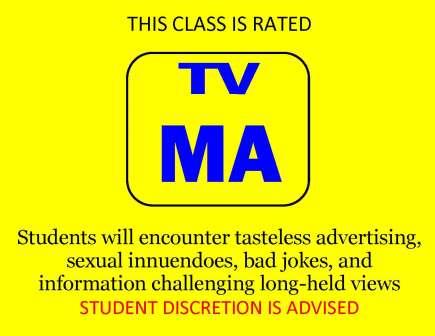1) Definitions, history & nature of business organizations
→ Belch & Belch, ch. 1, 2 & 3
→ Rotzoll, "The Coming of the Ads" [handout]
→ Who Do You Hire When the Advertising Audience Isn't You?
→ Creative Women in Advertising Agencies: Why So Few 'Babes in Boyland'? [handout]
→ optional: 'Mine is the Blue One on the Left': Function and Dysfunction of Pharmaceutical Brand Names
2) Basic Theories
→ Belch & Belch, ch. 4, 5 & 6
→ 'The Stealth Influence of Covert Marketing
→ Brand Image of Company Names Matters in Ways That Can't Be Ignored
→ optional: Fooled by Your Own Brain
3) Communication Goals/Objectives
→ Belch & Belch, pp. 215-238 (first half of chapter 7)
-- Preliminary research report can be turned in -- 4) Budget Setting
5) Creative Strategy & Tactics
→ Belch & Belch, ch. 8 & 9
→ How I Met the Late Howard Gossage
→ Imitation as the Sincerest Form of Ignorance
→ optional: Advertising Only a Copywriter Could Love
6) Media Management: Strategy
→ Belch & Belch, ch. 10
→ Is There a Strategy Behind Buying Advertising time and Space?
7) Media Selection: Broadcast ("Electronic")
→ Belch & Belch, ch. 11
→ "Understanding Advertising Clutter
8) Media Selection: Print
→ Belch & Belch, ch. 12
9) Media Selection: Supplemental Media
→ Belch & Belch, ch. 13, 14 & 15
→Wham! Spam! And Direct Misplaced Marketing
→Movie Theaters' Suicide-by-Advertising With Income from Abusing Customers
10) Sales Promotion & Publicity (not PR)
→ Belch & Belch, ch. 16 & p. 572-3 ("definition of PR") & p. 584-9
-- Term Paper Due Between Now & End of Term --
11) Research testing of effectiveness
→ Belch & Belch, ch. 18
→ Weilbacher, "Enigma of Copy Testing"
→ A Snapshot or a Painting? Metaphors, Myths, Misuses and Misunderstandings of Marketing Research Information by Journalists...
12) Regulation & self-regulation
→ Belch & Belch, ch. 20
→Desires Versus the Reality of Self-Regulation
→A Pessimist's Simplistic Historical Perspective on the Fourth Wave of Consumer Protection
→ recommended, if you have time and feel like it: Libraries, Learning and Dirty Sandals

 common business activities and terminology, perspectives applied when taking the optimal approach to decisions, plus descriptions and rationales of common practices, especially since the most common practices are often far from what would be optimal.
common business activities and terminology, perspectives applied when taking the optimal approach to decisions, plus descriptions and rationales of common practices, especially since the most common practices are often far from what would be optimal.